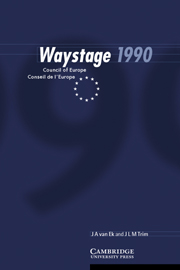Book contents
- Frontmatter
- Contents
- Preface
- Introduction
- 1 The objective: description
- 2 Components of the specification
- 3 Language functions
- 4 General notions
- 5 Themes and specific notions
- 6 Dealing with texts: reading and listening
- 7 Writing
- 8 Sociocultural competence
- 9 Verbal exchange patterns
- 10 Compensation strategies
- 11 Learning to learn
- 12 Degree of skill
- APPENDICES
2 - Components of the specification
Published online by Cambridge University Press: 01 March 2010
- Frontmatter
- Contents
- Preface
- Introduction
- 1 The objective: description
- 2 Components of the specification
- 3 Language functions
- 4 General notions
- 5 Themes and specific notions
- 6 Dealing with texts: reading and listening
- 7 Writing
- 8 Sociocultural competence
- 9 Verbal exchange patterns
- 10 Compensation strategies
- 11 Learning to learn
- 12 Degree of skill
- APPENDICES
Summary
The Waystage specification is not a closed syllabus, nor is the communicative ability described in it confined to a strictly limited number of specific situations. On the contrary: it is aimed at providing the learners with an overall basic skill in using the foreign language which, although it is primarily directed towards the requirements of selected situations, should give the learners a far wider range of action as well as a solid basis for further language learning. Thus, in spite of the limitations of its content, which are inherent in the concept of an ‘early learning objective’, Waystage does provide the learners with an ability to manipulate the language for their own purposes. This means, for instance, that at Waystage learners can fulfil a fairly wide range of essential language functions, although with very simple means, and that they can also express a large number of generally used concepts as well as understand others expressing them. Moreover, they will have at their disposal a fair number of communication strategies that will enable them to make the most of their as yet limited resources. Also, they will have been specifically prepared for functioning in those situations in which, on the whole, they are most likely to need the ability to use the foreign language, while having the potential to make at least a good attempt at coping with other situations as well.
- Type
- Chapter
- Information
- Waystage 1990Council of Europe Conseil de l'Europe, pp. 12 - 14Publisher: Cambridge University PressPrint publication year: 1999

